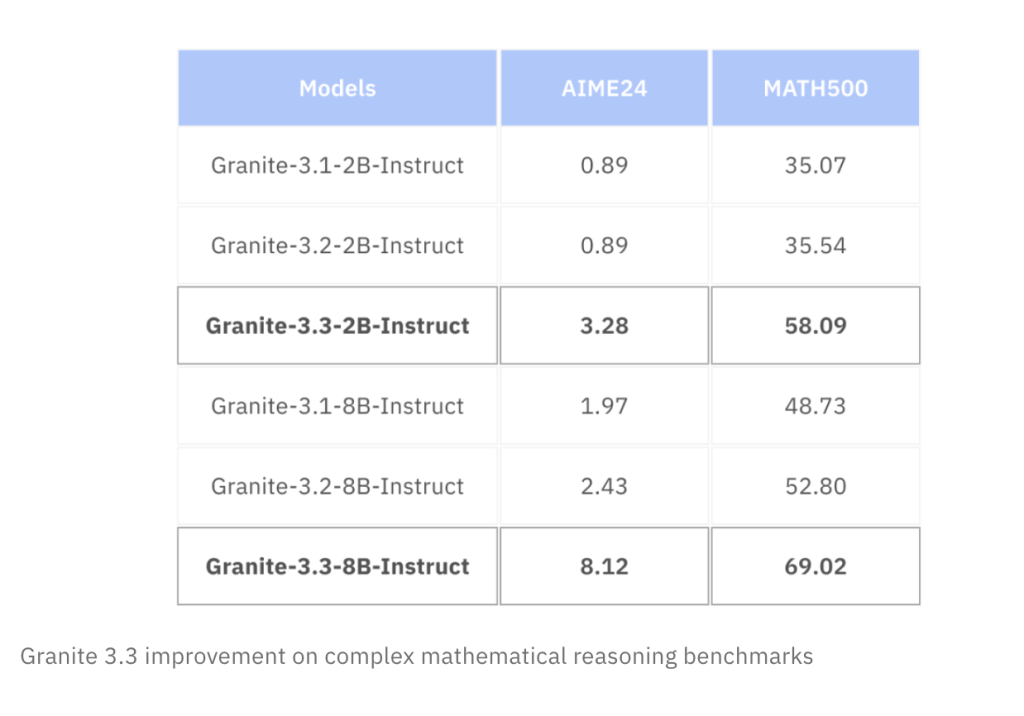As artificial intelligence continues to integrate into enterprise systems, the demand for models that combine flexibility, efficiency, and transparency has increased. Existing solutions often struggle to meet all these requirements. Open-source models may lack domain-specific capabilities, while proprietary systems sometimes limit access or adaptability. This shortfall is especially pronounced in tasks involving speech recognition, logical reasoning, and retrieval-augmented generation (RAG), where technical fragmentation and toolchain incompatibility create operational bottlenecks.
IBM Releases Granite 3.3 with Updates in Speech, Reasoning, and Retrieval
IBM has introduced Granite 3.3, a set of openly available foundation models engineered for enterprise applications. This release delivers upgrades across three domains: speech processing, reasoning capabilities, and retrieval mechanisms. Granite Speech 3.3 8B is IBM’s first open speech-to-text (STT) and automatic speech translation (AST) model. It achieves higher transcription accuracy and improved translation quality compared to Whisper-based systems. The model is designed to handle long audio sequences with reduced artifact introduction, enhancing usability in real-world scenarios.
Granite 3.3 8B Instruct extends the capabilities of the core model with support for fill-in-the-middle (FIM) text generation and improvements in symbolic and mathematical reasoning. These enhancements are reflected in benchmark performance, including outperforming Llama 3.1 8B and Claude 3.5 Haiku on the MATH500 dataset.

Technical Foundations and Architecture
Granite Speech 3.3 8B uses a modular architecture consisting of a speech encoder and LoRA-based audio adapters. This design allows for efficient domain-specific fine-tuning while retaining the generalization capacity of the base model. The model supports both transcription and translation tasks, enabling cross-lingual content processing.
The Granite 3.3 Instruct models incorporate fill-in-the-middle generation, supporting tasks such as document editing and code completion. Alongside, IBM introduces five LoRA adapters tailored for RAG workflows. These adapters support better integration of external knowledge, improving factual accuracy and contextual relevance during generation.
A notable addition is adaptive LoRA (aLoRA), which reuses the key-value (KV) cache across inference sessions. This leads to a reduction in memory consumption and latency, particularly in streaming or multi-hop retrieval environments. aLoRA is designed to offer better trade-offs between computational overhead and performance in retrieval-heavy workloads.

Benchmark Results and Platform Support
Granite Speech 3.3 8B demonstrates superior performance over Whisper-style baselines in transcription and translation across multiple languages. The model performs reliably on extended audio inputs, maintaining coherence and accuracy without significant drift.
In symbolic reasoning, Granite 3.3 Instruct shows improved accuracy on the MATH500 benchmark, outperforming comparable models at the 8B parameter scale. The RAG-specific LoRA and aLoRA adapters demonstrate enhanced retrieval integration and grounding, which are critical for enterprise applications involving dynamic content and long-context queries.
IBM has made all models, LoRA variants, and associated tools open-source and accessible via Hugging Face. Additionally, deployment options are available through IBM’s watsonx.ai, as well as third-party platforms including Ollama, LMStudio, and Replicate.
Conclusion
Granite 3.3 marks a step forward in IBM’s effort to develop robust, modular, and transparent AI systems. The release targets critical needs in speech processing, logical inference, and retrieval-augmented generation by offering technical upgrades grounded in measurable improvements. The inclusion of aLoRA for memory-efficient retrieval, support for fill-in-the-middle tasks, and advancements in multilingual speech modeling make Granite 3.3 a technically sound choice for enterprise environments. Its open-source release further encourages adoption, experimentation, and continued development across the broader AI community.
Check out the Model Series on Hugging Face and Technical details. Also, don’t forget to follow us on Twitter and join our Telegram Channel and LinkedIn Group. Don’t Forget to join our 90k+ ML SubReddit.
The post IBM Releases Granite 3.3 8B: A New Speech-to-Text (STT) Model that Excels in Automatic Speech Recognition (ASR) and Automatic Speech Translation (AST) appeared first on MarkTechPost.
Source: Read MoreÂ

 [Register Now] miniCON Virtual Conference on AGENTIC AI: FREE REGISTRATION + Certificate of Attendance + 4 Hour Short Event (May 21, 9 am- 1 pm PST) + Hands on Workshop
[Register Now] miniCON Virtual Conference on AGENTIC AI: FREE REGISTRATION + Certificate of Attendance + 4 Hour Short Event (May 21, 9 am- 1 pm PST) + Hands on Workshop
